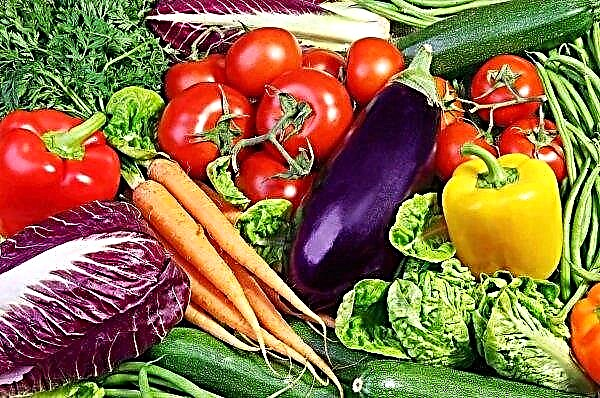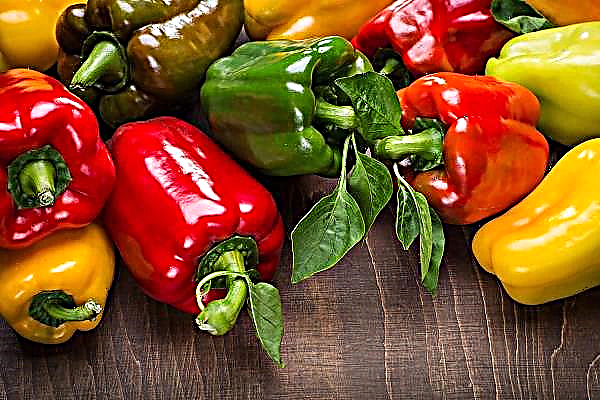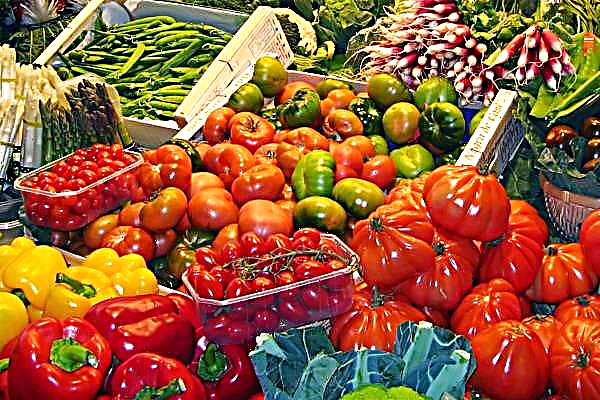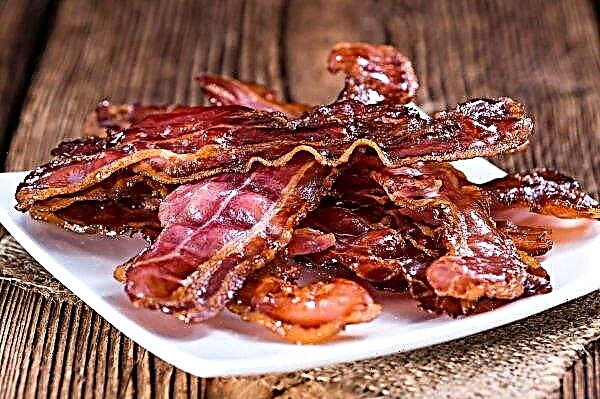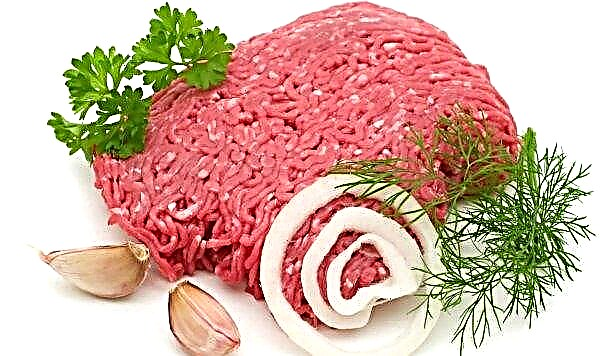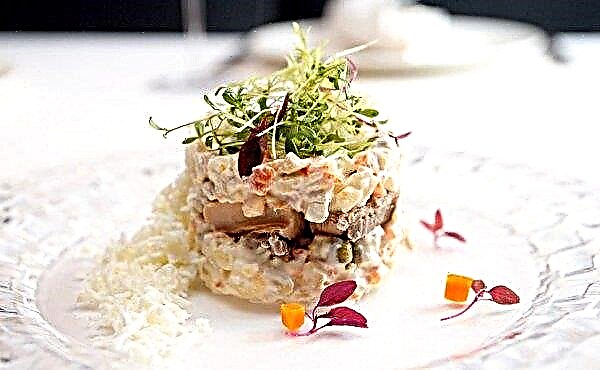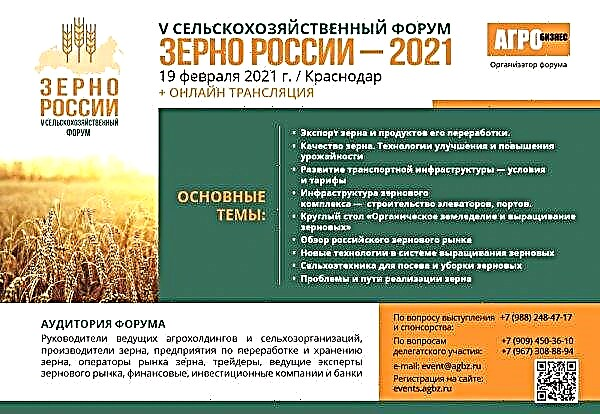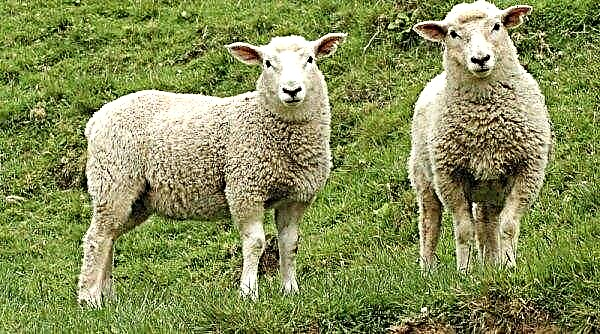Musk ducks, which we call indoctrines or mute swords, and in Western Europe they are completely mute, really do not know how to quack, but they give first-class dietary meat. In addition, these birds are characterized by unpretentious feeding and flexible character. Read more about indotok in the article below.
General description of the breed
The name of the indochka has no direct relation to the Indians, nor to the Indians, nor to the turkeys. With the latter they are associated only with some similarity in the growths that adorn the head of these birds. These growths, also called warts and corals, are located on the head of a musky duck above the beak and in the eye area. The bird itself is a large squat duck with a short neck and legs, but with a wide chest and powerful wings. Indochina males can reach a mass of 6 kg, and females - 3.5 kg.
Indochina males can reach a mass of 6 kg, and females - 3.5 kg.
The latter, in late March and early April, bring 8-14 eggs, which they carefully incubate for 35 days. Wild musky ducks are painted uniformly in dark tones, sometimes diluted with white feathers. But domestic ducks, bred by breeding, are extremely diverse in their color, the characteristic of their color occupies a rather wide palette.
Did you know? Although the common duck, justifying its belonging to waterfowl and having webbed feet, is very willing to swim in the water, the musk duck, also belonging to waterfowl and having the same feet with membranes, does not like ponds, preferring to sit on trees.
Colors of indochka are:
- black with a green tint on the wings and back and with purple on all other parts of the body with brown beak and metatarsus and brown eyes;
- brown, which are sometimes called red, whose chocolate color is occasionally diluted with white spots, wings and neck look almost black, and the red color of the beak is combined with brown metatarsals and eyes;
- walnutdiffering from the previous color in lighter tones with white spots;
- bluewhose radically blue coloration of the entire body is shaded by the dark fringing of some feathers with black paws, eyes and beak;
- white, brightly white plumage which harmonizes well with a light pink beak and yellow paws with gray eyes;
- black and white, the black color of which is interspersed with white colors on the head, neck and chest with light brown eyes and yellow metatarsus.
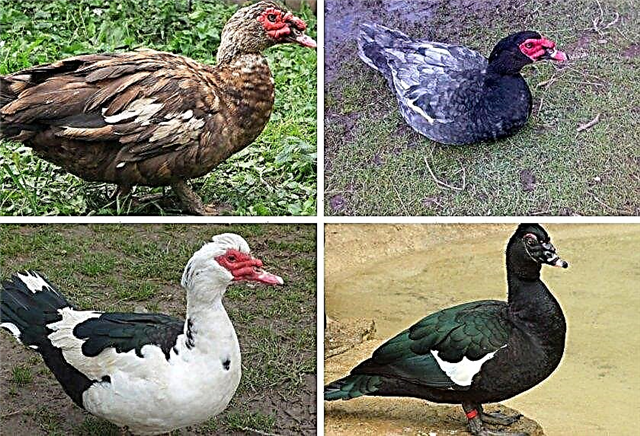
Advantages and disadvantages of the breed
- The undoubted advantages of indoorot include:
- very high gastronomic qualities of dietary lean meat;
- greater meat productivity;
- calm character and low noise of the herd;
- unpretentiousness in the content;
- good immunity;
- high egg production and congenital tendency of females to incubate eggs;
- cleanliness of birds.
- Among the few shortcomings are called:
- low cold resistance;
- intolerance to high humidity in the room;
- increased cravings for peeling everything shiny, which creates a great danger to birds in the presence of nails or broken glass on the ground.
Breeding, maintenance and care
Musk duck females incubate laid eggs in good faith only for 35 days. The hatched ducklings are then placed in spacious brooders under bright lighting and create an ambient temperature of + 28 ... + 30 ° С. They start feeding on the same day, pouring the first portion of food from above so that the ducklings can respond to its movement. The chicks should have free access to clean water, into which the duckling's beak is forcibly submerged at the first watering.
The chicks should have free access to clean water, into which the duckling's beak is forcibly submerged at the first watering.
From the age of two weeks, an aviary with ducklings should be taken out to fresh air. Since that time, drakes and ducks have been grown separately, since faster growing males are able to harm weaker females. Freshly hatched ducklings are fed up to 8 times a day. The initial diet consists of chopped chicken eggs and water. After a day, low-fat cottage cheese is added.
Important! Since indochka are the most clean among poultry, in no case should excessive crowding of chicks and adult musk ducks be kept in their places of detention.
A week later, the ducklings are transferred to a 5-time diet, which consists of:
- bran;
- ground grain;
- bone meal;
- meat waste;
- greens.
In the second month of the existence of ducklings, they are transferred to the diet of adult birds. It should be noted the almost omnivorous nature of the nutrition of these ducks. Indoor women eat any food, and in smaller quantities than ordinary ducks.
Indoor women eat any food, and in smaller quantities than ordinary ducks.
However, for the normal development of birds, their rapid weight gain and obtaining high quality meat from them, one should still adhere to the diet most preferred for musky ducks.
Best for them are feeds consisting of:
- grains;
- compound feed;
- maize;
- boiled potatoes;
- garden grass;
- chopped beet tops;
- kitchen waste;
- boiled meat waste.
As mentioned above, although these ducks belong to waterfowl and have webbed feet, they are indifferent to swimming in bodies of water and can do without it. But the forest existence of wild ancestors preserved the desire to fly up on tree branches in cultural species. For this reason, in the enclosures they often arrange the likeness of trees, and in the houses they make a night out for the birds.Important! Musk ducks do not fundamentally eat together with birds of other breeds from a common feeder. Therefore, they must be fed separately from other birds.
The rooms themselves must be dry, because Indoor women are extremely sensitive to high humidityequipped with daylight access windows and clean. In winter, they should not be cold, and daylight hours must be maintained within 12-16 hours. Since the Indians do not tolerate crowding, per 1 sq. m house should not be placed more than 3 birds.
Aviaries are fenced with a grid not only from the sides, but also from above, since musky ducks like to fly. To prevent flying in open spaces, feathers are shortened in birds. You can not cut the bird along lines 1 and 2, since this injures it, lines 3 - will not bring results. Possible cropping lines are 4, 5, 6.
You can not cut the bird along lines 1 and 2, since this injures it, lines 3 - will not bring results. Possible cropping lines are 4, 5, 6.The feeders should not only be separate, designed specifically for indoo, but also long enough so that at least 5 birds can feed at the same time. Tanks with shell rock, chalk and wood ash are located next to the feeders. Drinking bowls in the house are best used nipple for hygiene. In open-air cages it is useful to set wide tanks with water for swimming indolets.
Did you know? All 110 existing duck species have a rather short neck, in which, however, there are more cervical vertebrae than in the long neck of a giraffe.
Crossbreeding with birds of other species
Musk ducks successfully enough interbreed with ordinary ducks. By crossing the drakes of the indigenous birds with the females of the Peking white or Rouen breed of ducks, or with duck breeds the white alla and orgpington, hybrids are obtained, which are called mulards. As evidenced by the reviews of poultry farmers, mulard hybrids turn out to be larger than indigenous, gain weight faster, are more cold-resistant, and earlier reach puberty.
As evidenced by the reviews of poultry farmers, mulard hybrids turn out to be larger than indigenous, gain weight faster, are more cold-resistant, and earlier reach puberty.
However, there are losses in the form of more fatty meat in hybrids, their greater noisiness and uncleanliness, and a less developed instinct for egg incubation. As a result, mullards, in their quality indicators, occupy an intermediate step between musky and ordinary ducks.
The musky duck is gaining more and more strength in poultry houses around the world. This expansion is promoted by very high gastronomic conditions of its meat, calm nature of birds, their undemanding for feed. The increased requirements of indigenous women to the dryness and cleanliness of their homes are repeatedly paid for by the virtues of these birds.



